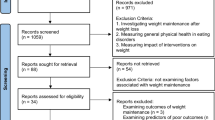Abstract
Obesity is a major health concern for a large proportion of the population, yet many obese individuals do not receive weight loss treatment. The present study investigated weight-loss treatment seeking and barriers that may prevent treatment seeking. A community sample of overweight or obese participants (N=154; Mean BMI=33.3 kg/m2) completed an Internet survey assessing treatment seeking behaviors across three categories: Treatments Sought, Treatments Desired, and Treatments Planned. Seven treatments of different intensity levels and five barriers to treatment seeking were evaluated. The weight-loss treatment most frequently sought, desired, and planned was treatment “on own.” Higher BMI was correlated with greater number of treatments sought. However, 10% of respondents reported zero treatments sought, and over 25% reported zero treatments desired or planned. Perceived barriers may explain reluctance to seek treatment. The top two barriers for all treatments were lack of money and time. Higher BMI was correlated with more total perceived barriers, and specifically with the barriers “I feel/think I am too heavy” and “I am afraid people will treat me unfairly or badly.” More barriers were reported for more intensive treatments such as treatments from a doctor, another professional, or a commercial program. A majority of participants reported zero barriers to less-intensive treatments. These results suggest that many obese individuals who might benefit from weight loss treatment nevertheless do not plan or desire to seek treatment and perceive multiple barriers to treatments. However, these individuals could be encouraged to consider the less intensive treatments that are seen as more barrier-free.
Similar content being viewed by others
References
Leavitt MO. Physical activity and good nutrition: essential elements to prevent chronic diseases and obesity 2007. US Department of Health and Human Services, Center for Disease Control and Prevention, 2007.
Hedley AA, Ogden CL, Johnson CL, et al. Prevalence of overweight and obesity among US children, adolescents, and adults, 1999–2002. JAMA 2004; 291: 2847–50.
Butryn ML, Phelan S, Wing RR. Self-guided approaches to weight loss. In: Latner JL, Wilson GT (Eds) Selfhelp approaches for obesity and eating disorders. New York, Guilford Press, 2007, pp 3–20.
Wadden TA, Butryn ML, Byrne KJ. Efficacy of lifestyle modification for long-term weight control. Obes Res 2004; 12: 151S–62S.
Dansinger ML, Tatsioni A, Wong JB, et al. Meta analysis: The effect of dietary counseling for weight loss. Ann Intern Med 2007; 147: 41–50.
Teixeira PJ Palmeira AL, Branco TL, et al. Who will lose weight? A reexamination of predictors of weight loss in women. Int J Behav Nutr Phys Act 2004; 1: 1–12.
Teixeira PJ, Going SB, Houtkooper LB, et al. Pretreatment predictors of attrition and successful weight management in women. Int J Obes 2004; 28: 1124–33.
Marchesini G, Cuzzolaro M, Mannucci E, et al. Weight cycling in treatment-seeking obese persons: Data from the QUOVADIS study. Int J Obes 2004; 28: 1456–62.
Gibbons LM, Sarwer DB, Crerand CE, et al. Previous weight loss experiences of bariatric surgery candidates: How much have patients dieted prior to surgery? Obesity 2006; 14: 70S–6S.
French SA, Jeffery RW. Current dieting, weight loss history, and weight suppression: Behavioral correlates of three dimensions of dieting. Addict Behav 1997; 22: 31–44.
Olson CL, Schumaker HD, Yawn BP. Overweight women delay medical care. Arch Fam Med 1994; 3: 888–92.
Gosling SD, Vazire S, Srivastava S, et al. Should we trust web-based studies? A comparative analysis of six preconceptions about internet questionnaires. Am Psychol 2004; 59: 93–104.
French SA, Jeffery RW, Story M, et al. Perceived barriers to and incentives for participation in a weight-loss program among low-income women in WIC. J Am Diet Assoc 1998; 98: 79–81.
Black DR, Threlfall WE. A stepped approach to weight control: a minimal intervention and a bibliotherapy problem solving program. Behav Ther 1986; 17: 144–57.
Crandall CS. Prejudice against fat people: ideology and self-interest. J Pers Soc Psychol 1994; 66: 882–94.
DeJong W. The stigma of obesity: The consequences of naïve assumptions concerning the causes of physical deviance. J Health Soc Behav 1980; 21: 75–87.
Foster GD, Wadden TA, Vogt RA, et al. What is a reasonable weight loss? Patients’ expectations and evaluations of obesity treatment outcomes. J Consult Clin Psychol 1997; 65: 79–85.
Mann T, Tomiyama AJ, Westling E, et al. Medicare’s search for effective obesity treatments: Diets are not the answer. Am Psychol 2007; 62: 220–33.
Puhl RM, Brownell KD. Confronting and coping with weight stigma: An investigation of overweight and obese individuals. Obesity 2006; 14: 1802–15.
Latner JD. Self-help in the long-term treatment of obesity. Obes Rev 2001; 2: 87–97.
Jorm AF, Griffiths KM. Population promotion of informal self-help strategies for early intervention against depression and anxiety. Psychol Med 2006; 36: 3–6.
Nieto-Garcia FJ, Bush TL, Keyl PM. Body mass definitions of obesity: sensitivity and specificity using selfreported weight and height. Epidemiology 1990; 1: 146–52.
Allegri C, Russo E, Roggi C, et al. Quality of life (QoL) and motivation for treatment: a female issue? Eat Weight Disord 2008; 13: e8–e13.
O’Brien K, Venn BJ, Perry T, et al. Reasons for wanting to lose weight: different strokes for different folks. Eat Behav 2007; 8: 132–5.
Author information
Authors and Affiliations
Corresponding author
Additional information
Portions of this manuscript were presented at the 2008 Academy of Eating Disorders International Conference, Seattle, WA.
Rights and permissions
About this article
Cite this article
Ciao, A.C., Latner, J.D. & Durso, L.E. Treatment seeking and barriers to weight loss treatments of different intensity levels among obese and overweight individuals. Eat Weight Disord 17, e9–e16 (2012). https://doi.org/10.1007/BF03325323
Received:
Accepted:
Published:
Issue Date:
DOI: https://doi.org/10.1007/BF03325323




